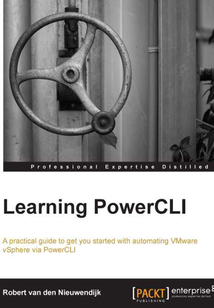舉報 

會員
Learning PowerCLI
最新章節:
Index
LearningPowerCLIiswritteninafriendlyandpracticalstylewithafocusongettingyoustartedandautomatingdailytasksquicklyandefficiently.IfyoumanageoradministrateavSphereenvironment,andwanttomakethateasierandmoreefficient,thenthisbookisforyou!ThisbookisidealforyouifyouwanttolearnhowtoautomateyourVMwarevSphereinfrastructure,bygettingthemostoutofPowerCLI.It’sassumedthatyouhavesomeexperienceinadministratingaVMwarevSphereenvironment.KnowledgeofMicrosoft’sWindowsPowerShellisnotaprerequisite.
目錄(118章)
倒序
- coverpage
- Credits
- Learning PowerCLI
- About the Author
- About the Reviewers
- www.PacktPub.com
- Support files eBooks discount offers and more
- Preface
- What this book covers
- What you need for this book
- Who this book is for
- Conventions
- Reader feedback
- Customer support
- Chapter 1. Introduction to PowerCLI
- Downloading and installing PowerCLI
- Modifying the PowerShell execution policy
- Connecting and disconnecting servers
- Using the credential store
- Retrieving a list of all of your virtual machines
- Retrieving a list of all of your hosts
- Summary
- Chapter 2. Learning Basic PowerCLI Concepts
- Using the Get-Command Get-Help and Get-Member cmdlets
- Using providers and PSDrives
- Using arrays and hash tables
- Creating calculated properties
- Using raw API objects with ExtensionData or Get-View
- Extending PowerCLI objects with the New-VIProperty cmdlet
- Working with vSphere folders
- Summary
- Chapter 3. Working with Objects in PowerShell
- Using objects properties and methods
- Expanding variables and subexpressions in strings
- Using here-strings
- Using the pipeline
- Using the PowerShell object cmdlets
- Creating your own objects
- Using COM objects
- Summary
- Chapter 4. Managing vSphere Hosts with PowerCLI
- Adding a host to a VMware vCenter Server
- Enabling and disabling maintenance mode
- Working with host profiles
- Working with host services
- Configuring the host firewall
- Configuring vSphere Image Builder and Auto Deploy
- Using esxcli from PowerCLI
- Using the vSphere CLI commands from PowerCLI
- Removing a host from the VMware vCenter Server
- Summary
- Chapter 5. Managing Virtual Machines with PowerCLI
- Creating a virtual machine
- Registering a virtual machine
- Using OS customization specifications
- Starting and stopping a virtual machine
- Modifying the settings of a virtual machine
- Converting a virtual machine into a template
- Moving a virtual machine to another folder host cluster resource pool or datastore
- Updating the VMware Tools
- Upgrading virtual machine compatibility
- Using snapshots
- Running commands on the guest OS
- Configuring Fault Tolerance
- Opening the console of a virtual machine
- Removing a virtual machine
- Summary
- Chapter 6. Managing Virtual Networks with PowerCLI
- Using vSphere Standard Switches
- Using host network adapters
- Using standard port groups
- Using vSphere Distributed Switches
- Removing vSphere Distributed Switches
- Using distributed virtual port groups
- Configuring host networking
- Configuring the network of a virtual machine
- Summary
- Chapter 7. Managing Storage with PowerCLI
- Rescanning for new storage devices
- Creating datastores
- Retrieving datastores
- Setting the multipathing policy
- Configuring the vmhba paths to a SCSI device
- Working with Raw Device Mappings
- Configuring Storage I/O Control
- Configuring Storage DRS
- Upgrading datastores to VMFS-5
- Removing datastores
- Summary
- Chapter 8. Managing High Availability and Clustering with PowerCLI
- Creating vSphere HA and DRS clusters
- Retrieving clusters
- Modifying cluster settings
- Moving hosts to clusters
- Moving clusters
- Using DRS rules
- Using DRS recommendations
- Using resource pools
- Using Distributed Power Management (DPM)
- Removing clusters
- Summary
- Chapter 9. Managing vCenter with PowerCLI
- Working with roles and permissions
- Managing licenses
- Configuring alarms
- Retrieving events
- Summary
- Chapter 10. Reporting with PowerCLI
- Retrieving log files
- Creating log bundles
- Performance reporting
- Exporting reports to CSV files
- Generating HTML reports
- Sending reports by e-mail
- Reporting the health of your vSphere environment with vCheck
- Using PowerGUI
- Summary
- Index 更新時間:2021-07-19 18:22:52
推薦閱讀
- 新媒體跨界交互設計
- INSTANT ForgedUI Starter
- 計算機組裝與維修技術
- Visual Media Processing Using Matlab Beginner's Guide
- 計算機組裝維修與外設配置(高等職業院校教改示范教材·計算機系列)
- Hands-On Artificial Intelligence for Banking
- 深入理解序列化與反序列化
- Hands-On Motion Graphics with Adobe After Effects CC
- Python Machine Learning Blueprints
- 單片微機原理及應用
- Istio實戰指南
- 觸摸屏應用技術從入門到精通
- The Applied Artificial Intelligence Workshop
- The Machine Learning Workshop
- 3D打印:Geomagic Design X5.1 逆向建模設計實用教程
- Arduino+3D打印創新電子制作2
- Hands-On Embedded Programming with C++17
- 微處理器及控制電路識圖
- FPGA的人工智能之路:基于Intel FPGA開發的入門到實踐
- R Graphs Cookbook Second Edition
- Spring Cloud Alibaba大型微服務架構項目實戰(下冊)
- Axure RP Prototyping Cookbook
- 新型電腦顯示器維修數據速查寶典
- 單片機原理及應用(第2版)
- Direct3D Rendering Cookbook
- 可編程序控制器應用技術(第3版)
- IntelliJ IDEA Essentials
- The Applied TensorFlow and Keras Workshop
- Spring Boot+Spring Cloud微服務開發實戰
- STC單片機原理及應用:從器件、匯編、C到操作系統的分析和設計(立體化教程)(第2版)

